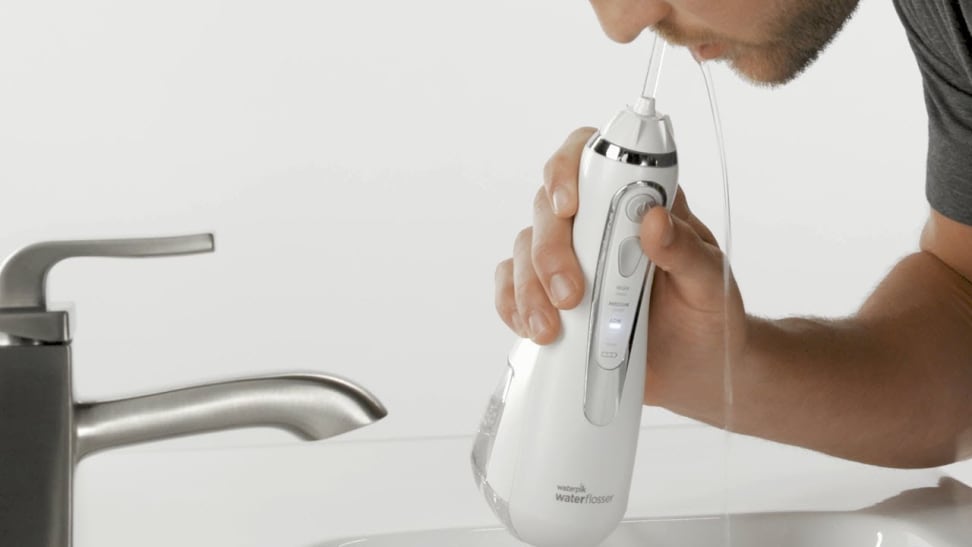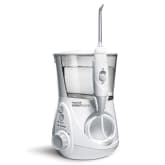Written by Alex Kane, gaming and culture journalist and storyteller
Ceara Perez-Murphy, staff writer, and product tester who's known to give great gifts.
Updated August 28, 2025
The Rundown
- Our favorite water flossers are the Waterpik Aquarius Professional Water Flosser and the MySmile Cordless Oral Irrigator.
- Water flossers effectively remove plaque and debris from hard-to-reach areas, including below the gum line, complementing traditional flossing for a healthier mouth.
- Consider reservoir size, power source, and interchangeable tips for specific dental needs or sharing. Adjustable pressure settings are crucial for comfort and effective cleaning.
Whether you’re looking to improve your long-term gum health, help out your toothbrush, floss around things like bracers and permanent retainers, or just want to keep your teeth sparkling clean on long business trips, water flossing can change your oral health for the better. But it’s something you’ll want to ask your dentist about; in many cases, it works best as a supplement to string flossing, rather than a full replacement.
Water flossers come in a variety of sizes and price ranges, but their main differences are pretty straightforward: reservoir size, power source, and accessories. Interchangeable tips help you with various oral-hygiene-related tasks as well as letting you share the irrigator with family members.
Your tolerance for water pressure may be a factor in your decision, as some of the higher-powered products have fewer pressure settings and modes than others—you don’t want something that’s going to cause you pain. A larger reservoir will generally be better if you’re keeping the flosser in one bathroom all the time; it’ll save you having to refill the device midway through flossing.
Here are some of the best water flossers, oral irrigators, and water picks to shop online now.
Benefits of Using a Water Flosser
Water flossers aren’t a replacement for flossing with regular dental floss, but using them regularly has a host of dental benefits. Water flossers can remove more plaque and residue than brushing alone can, so when you pair using the best water flosser with the best floss, you have a winning combination for a healthy mouth. Water flossers are also unmatched at reaching hard-to-get spots in your mouth (think your back molars) that often get skipped when flossing with regular floss and even brushing — and the pressurized water stream can even reach below the gumline and into otherwise inaccessible periodontal pockets. The result is a healthier mouth, with stronger gums and better breath.
Water Flosser vs. Traditional Flossing
The best water flossers and the best dental floss both have the same aim — cleaner, plaque-free teeth. But they’re best thought of as complements to each other, getting the best results when used in tandem.
Traditional floss: The best floss is incredibly effective at getting in between tightly packed teeth to physically scrape plaque, food, and anything else off the teeth before it can build up. It’s inexpensive, takes up almost no room in a drawer, and you can get it anywhere. However, it can be difficult to get your fingers and the floss into notoriously tight spots (think the back molars) which makes incorrect flossing or skipping the spot more likely. Flossing too hard can also cause bleeding, and users with limited dexterity from arthritis or any other reason can find the small motor movements required to manuever the floss where it needs to go challenging.
Water flossers: Water flossers excel at removing plaque and debris from hard-to-reach areas, including below the gum line, that regular floss can’t touch. The adjustable pressure of water flossers means even sensitive users can get a thorough clean without pain. On the other hand, water flossers are costly and incur further cost to use since they need to be powered (whether that’s being plugged into an outlet or with batteries) and refilled with water. They need regular cleaning, and they take up space on your counter.
So which is better? We recommend using a water flosser after flossing to take advantage of both their strengths. However, users with mobility limitations in their hands, sensitive gums, or dental appliances may especially benefit from water flosser use.
Key Features to Look for in a Water Flosser Device
The best water flosser for you is one you’ll use. To narrow it down, here’s what we recommend looking at.
* Water Pressure Settings and Modes: Pressure that’s too forceful will hurt your gums; pressure that’s too weak won’t clean adequately. The best water flossers let you adjust the amount of pressure (measured in PSIs) in the stream to find the right intensity for your needs. Some models also have preset modes like gentle mode, normal mode, or massage/pulse settings that let you select a given pressure and stream type for ease of use.
Reservoir Capacity: Larger tanks don’t need to be refilled as often, but take up more space on your bathroom counter. Smaller tanks are a better fit for bathrooms short on space or for those who want to travel with their flossers.
Specialized Tips: If you will be using your water flosser for specific dental needs (or sharing your flosser with family members with differing needs), interchangeable tips can ensure you get the most out of the device. Apart from a standard angled jet tip, some models come with swappable tips that can include orthodontic tips designed to more thoroughly clean braces and retainers; plaque seeker tips with thin bristles meant for cleaning around dental implants, bridges, and crowns; and periodontal pocket tips made with rubber designed to aim a gentle stream below the gumline.
Ease of Use: The right water flosser is designed to make your life easier. Features like easy-to-fill reservoirs, cordless design, and quiet motors, as well as easy tip storage can make a big difference in how often you want to use your water flosser
More Efficient Cleaning for Braces, Dental Implants, and Dental Appliances
If you’re dealing with braces, expanders, dental implants, bridges, crowns, or any other kind of dental appliance, you know that keeping the surrounding teeth and gums clean and plaque-free can be a major challenge – and a water flosser can be a major help. The gentle streams of pressurized water emitted by a water flosser are unparalleled at reaching awkward or hard-to-access areas that brushing and regular flossing can inadvertently skip. Using specialized tips can make it even easier.
More Articles About Personal Care on Reviewed














